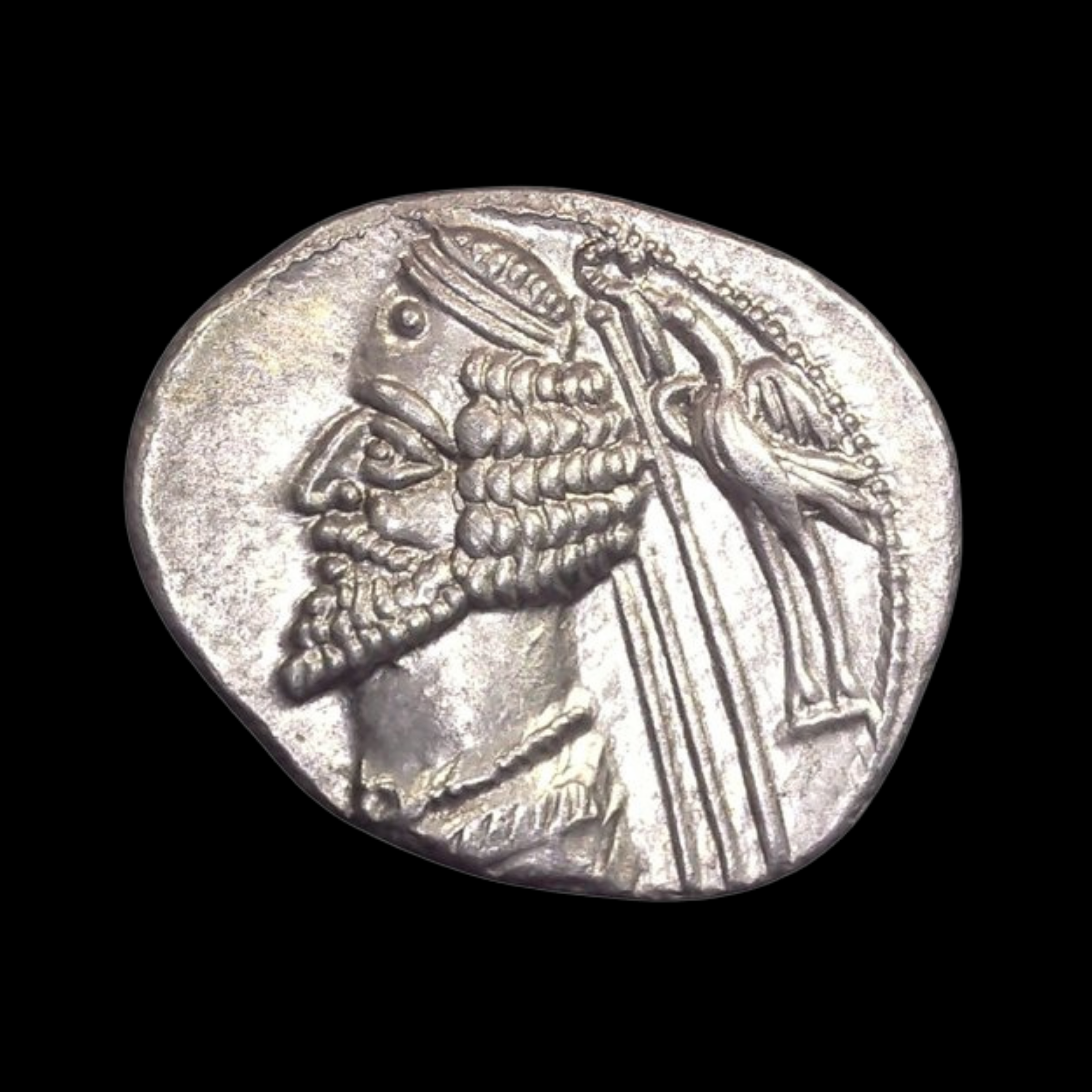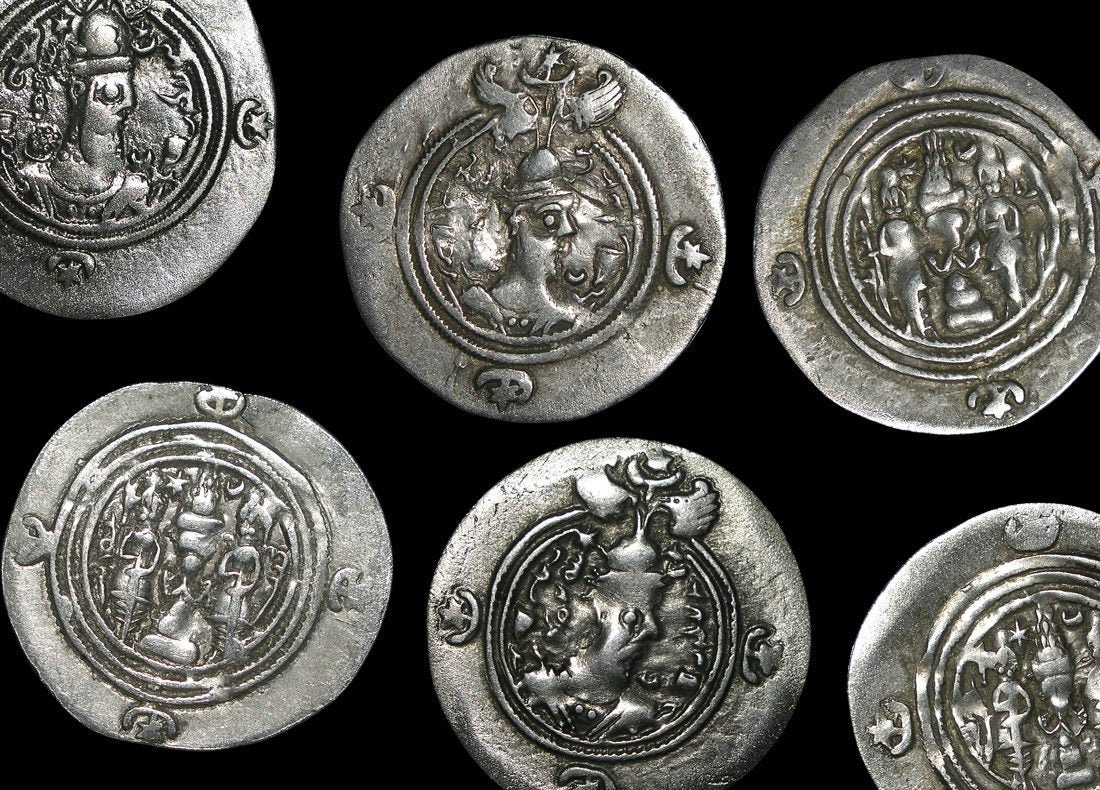 Image 1 of 10
Image 1 of 10

 Image 2 of 10
Image 2 of 10

 Image 3 of 10
Image 3 of 10

 Image 4 of 10
Image 4 of 10

 Image 5 of 10
Image 5 of 10

 Image 6 of 10
Image 6 of 10

 Image 7 of 10
Image 7 of 10

 Image 8 of 10
Image 8 of 10

 Image 9 of 10
Image 9 of 10

 Image 10 of 10
Image 10 of 10











Indo-Scythian Silver Coin of King Azes II (about 2,020-2,060 years ago)
This silver drachm represents the Indo-Scythian Kingdom under King Azes II, who ruled territories spanning modern Afghanistan and Pakistan around the time of Christ's birth. Similar to but smaller than the tetradrachm version, this drachm features the same culturally significant bilingual inscriptions and imagery, potentially connecting to biblical narratives through the legendary "Journey of the Magi."
Coin Description:
Front side: King Azes II on horseback, wearing Central Asian or Scythian attire, with Greek inscription giving his name and titles
Back side: Standing figure of Zeus (Greek king of gods) holding scepter, with inscription in Kharoshthi script (an ancient Indian writing system)
Technical Details:
Silver composition
Denomination: Drachm (a quarter of a tetradrachm)
NGC certified
Minted approximately 35 BC - 5 AD
Weight: Typically around 2.4 grams
Condition as certified by NGC
Historical Significance: This drachm represents the fascinating cultural fusion that occurred in Central Asia following Alexander the Great's conquests. The Indo-Scythian kingdom ruled by Azes II stood at the crossroads of several civilizations, incorporating Greek, Persian, Indian, and Central Asian influences. The coin's bilingual nature—Greek script on the obverse and Indian Kharoshthi script on the reverse—reflects this multicultural character. Some scholars connect these coins to biblical history, suggesting the "Magi" who followed a star to Bethlehem may have been Zoroastrian priests or astronomers from this region, possibly sent as envoys by King Azes himself. This connection makes these well-preserved 2,000-year-old coins particularly significant as potential physical links to one of history's most famous narratives, representing the complex interconnections between ancient civilizations during this pivotal historical period.
This silver drachm represents the Indo-Scythian Kingdom under King Azes II, who ruled territories spanning modern Afghanistan and Pakistan around the time of Christ's birth. Similar to but smaller than the tetradrachm version, this drachm features the same culturally significant bilingual inscriptions and imagery, potentially connecting to biblical narratives through the legendary "Journey of the Magi."
Coin Description:
Front side: King Azes II on horseback, wearing Central Asian or Scythian attire, with Greek inscription giving his name and titles
Back side: Standing figure of Zeus (Greek king of gods) holding scepter, with inscription in Kharoshthi script (an ancient Indian writing system)
Technical Details:
Silver composition
Denomination: Drachm (a quarter of a tetradrachm)
NGC certified
Minted approximately 35 BC - 5 AD
Weight: Typically around 2.4 grams
Condition as certified by NGC
Historical Significance: This drachm represents the fascinating cultural fusion that occurred in Central Asia following Alexander the Great's conquests. The Indo-Scythian kingdom ruled by Azes II stood at the crossroads of several civilizations, incorporating Greek, Persian, Indian, and Central Asian influences. The coin's bilingual nature—Greek script on the obverse and Indian Kharoshthi script on the reverse—reflects this multicultural character. Some scholars connect these coins to biblical history, suggesting the "Magi" who followed a star to Bethlehem may have been Zoroastrian priests or astronomers from this region, possibly sent as envoys by King Azes himself. This connection makes these well-preserved 2,000-year-old coins particularly significant as potential physical links to one of history's most famous narratives, representing the complex interconnections between ancient civilizations during this pivotal historical period.
This silver drachm represents the Indo-Scythian Kingdom under King Azes II, who ruled territories spanning modern Afghanistan and Pakistan around the time of Christ's birth. Similar to but smaller than the tetradrachm version, this drachm features the same culturally significant bilingual inscriptions and imagery, potentially connecting to biblical narratives through the legendary "Journey of the Magi."
Coin Description:
Front side: King Azes II on horseback, wearing Central Asian or Scythian attire, with Greek inscription giving his name and titles
Back side: Standing figure of Zeus (Greek king of gods) holding scepter, with inscription in Kharoshthi script (an ancient Indian writing system)
Technical Details:
Silver composition
Denomination: Drachm (a quarter of a tetradrachm)
NGC certified
Minted approximately 35 BC - 5 AD
Weight: Typically around 2.4 grams
Condition as certified by NGC
Historical Significance: This drachm represents the fascinating cultural fusion that occurred in Central Asia following Alexander the Great's conquests. The Indo-Scythian kingdom ruled by Azes II stood at the crossroads of several civilizations, incorporating Greek, Persian, Indian, and Central Asian influences. The coin's bilingual nature—Greek script on the obverse and Indian Kharoshthi script on the reverse—reflects this multicultural character. Some scholars connect these coins to biblical history, suggesting the "Magi" who followed a star to Bethlehem may have been Zoroastrian priests or astronomers from this region, possibly sent as envoys by King Azes himself. This connection makes these well-preserved 2,000-year-old coins particularly significant as potential physical links to one of history's most famous narratives, representing the complex interconnections between ancient civilizations during this pivotal historical period.
Azes II (Greek: Ἄζης Azēs, epigraphically ΑΖΟΥ Azou; Kharosthi: 𐨀𐨩 A-ya, Aya[1]), may have been the last Indo-Scythian king, speculated to have reigned circa 35–12 BCE, in what is Pakistan today. His existence has been questioned; if he did not exist, artefacts attributed to his reign, such as coins, are likely to be those of Azes I.[2]
After the death of Azes II, the rule of the Indo-Scythians in northwestern India and Pakistan finally crumbled with the conquest of the Kushans, one of the five tribes of the Yuezhi who had lived in Bactria for more than a century, and who were then expanding into India to create a Kushan Empire. Soon after, the Parthians invaded from the west. Their leader Gondophares temporarily displaced the Kushans and founded the Indo-Parthian Kingdom that was to last until the middle of the 1st century CE. The Kushans ultimately regained northwestern India circa 75 CE, where they were to prosper for several centuries.
Azes's name is attested on his coins in the Greek form Azēs (Ἄζης) and the Kharosthi form Aya (𐨀𐨩),[1] which are both derived from the Saka name *Aza, meaning "leader".[3]
You Might Also Like










